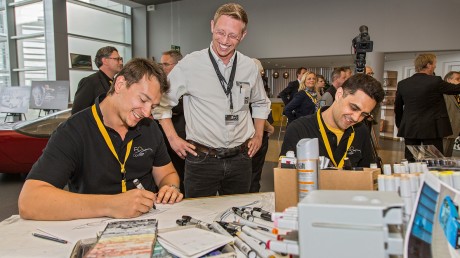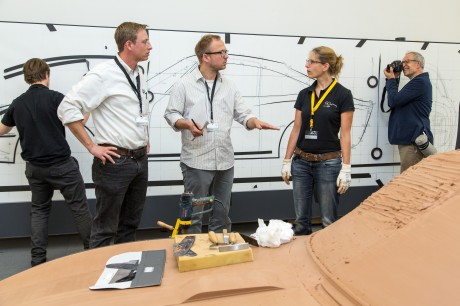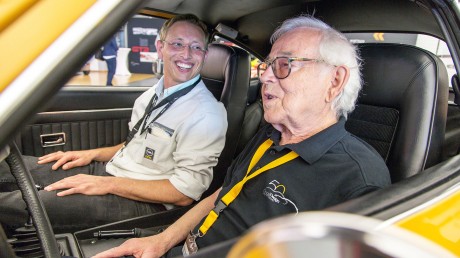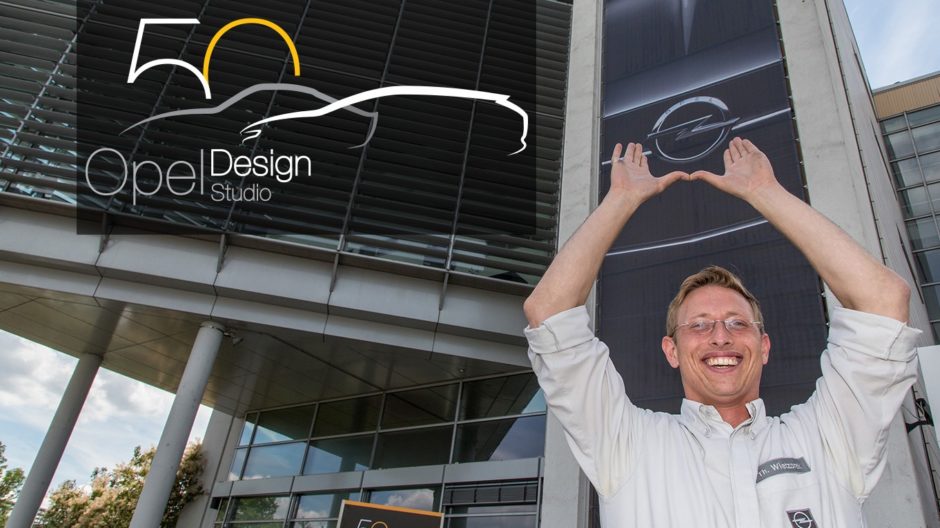- Clearly thrilled: Thomas Wietzorek gives the thumbs up, posing here with a clay model of the Monza Concept. The Quality Assurance employee is getting a firsthand look at advances in vehicle development at the Design Center.
- In the recreated 1960s-era studio, Wietzorek does the obvious and climbs into an Experimental GT.
- Just as it was back then, the pencil is still the most important tool of every car designer.
- Leberecht Fröhlich shows Wietzorek the drawing board and a GT sketch (package plan) in original size. These were two of the main tools of the creative department at Opel from 1964 until the beginning of the 1990s.
- Oliver Elst demonstrates the concept of ‘tape drawing’: A life-size drawing of the GT is mounted on a matt film onto which tape strips can be applied to form the lines of the chassis.
- Wietzorek lends a hand and is amazed to discover that “even though the frame and the measurements are predefined, the chassis can still be customized and made to look more streamlined or more aggressive and sportier.”
- The fun continues for the Quality Assurance employee as he moves on to the clay model of the GT. Today, a milling machine does most of the modeling.
- Triumphant at the end: The visit to the Design Center has been well worth it. Now Wietzorek can return to his workplace and help out his team with a technical problem they face.
When his greatest wish finally came true, Thomas Wietzorek had other things on his mind. “Oh man,” he says, shaking his head. “I don’t know whether I can enjoy myself here.” Although Wietzorek has been with Opel for 16 years, he had never been to the Design Center in Rüsselsheim. “This place is a huge draw for car lovers such as myself,” says Wietzorek. “At the same time, the building is as inaccessible to non-designers as Fort Knox is to gold thieves.” Wietzorek can now finally enter the hallowed halls of the Design Studio, normally closed to all but staff.
Diving into a Totally New World
But the tense look on his face is not one of excitement. His thoughts are still with his fellow employees from Chassis–Quality Assurance. “There is major technical issue back at work, so I will only be able to stay for a short time at the Design Center and then I have to go.” Wietzorek says this on the escalator leading to the second floor of Opel’s creative workshop. It is a veritable stairway to heaven. Now, twenty seconds later, the qualified production mechanic enters “a totally new world, one that I had never seen before,” he later admits. As for his concerns about work, he left them behind somewhere along the way from the escalator to the 1965 Experimental GT, in whose direction he is now headed.

Thomas Wietzorek looking over the shoulders of Andrey Gusev (left) and Pierre-Olivier Garcia.
Craftsmanship from an Era Before Computers Meet the Future
It is Thursday of last week and the first of three days of festivities at the Design Center. The department is celebrating its 50th anniversary this year. Opel co-workers and the general public have been invited. An historical exhibition is being held for the occasion where visitors can admire iconic cars such as the GT, Manta, and Insignia. The designers also offer a glimpse behind the scenes of their work. They explained how things were done decades ago when there were no computers and gave a live demonstration on future design technologies, displayed on computer monitors, and the latest Opel design study, the Monza Concept.
“I’m Getting Weak in the Knees”
Wietzorek, the chassis specialist from Quality Assurance, gets to see the Design Center on an exclusive tour for automotive journalists. He is taking part as a guest of Opel Post. His overall impression of the second floor, on which a 1960s-era studio has been recreated for the retro exhibit: “I’m getting weak in the knees. There is so much tradition here, so much Opel, and so much pride.” Wietzorek is overwhelmed by the atmosphere – part loft, part museum, both stylish and cozy at the same time. Numerous sketches and drawings hang on the walls, most of them made by design legend Erhard Schnell, who captured the zeitgeist at the time and was the visionary behind many influential car designs, among them the GT.
Pencils, Pastels, and Lighter Fluid
Now Wietzorek’s journey through time has really begun: In the middle of the room, designers Andrey Gusev and Pierre-Olivier Garcia are making pencil and pastel-chalk drafts of the GT and the CD luxury coupé (1969). While doing so, they explain how lighter fluid was used to create color contrasts. Further ahead is the ‘tape drawing’ station, where a life-size drawing of the GT is mounted on a matt film and Oliver Elst shows Wietzorek how he applies strips of tape to form the lines of the chassis.

Model designer Henny Tomczak (r.) explains the ins and outs of clay modeling.
Chisel, Marvel, Compare
The studio visitor is soon working up a sweat as he chisels away at the life-size clay GT model using knives, slicks, and sheets of metal. The material is a mixture of plasticine and clay. “This used to be the perfect method for checking the measurements and looks of a vehicle and making fine adjustments – and it still is to this day,” says model designer Henry Tomczak. The real-life classics stand just next to it. Wietzorek likes the ocher-colored GT the best.
Snapshot with the Legend
“My own private Opel classic, a 1979 Kadett D, is the same color,” he says. “I always tinker around on it in my spare time.” The elderly gentleman is in total agreement with Wietzorek. He is also the reason Wietzorek’s jaw has dropped right now. He is the master, in flesh and blood: Erhard Schnell, the man who influenced the Opel design style for decades. Now 85, he is a guest of honor at the festivities and the interview subject most sought after by the many reporters on hand. He nonetheless finds time for Wietzorek and the two of them talk about the Kadett series, the 1983 Junior concept car, and the success of the Calibra. They quickly take a souvenir photo together in the GT. And then Wietzorek is headed back to the future.

Encounter with a legend: Wietzorek and Erhard Schnell, who designed the GT.
Modern Times Await on the Ground Floor
It is back to the present on the ground floor: computers with huge monitors on which the designers collect, discuss, and refine ideas for new models. Vehicle development 2.0. Special software is used that enables 3D views in a virtual world and high resolution for precise detail. But even the design pioneers of today cannot get by without clay models. Next to the 1:3 scale models of the ADAM is a Monza Concept in clay, which has not been molded but instead produced overnight by a milling machine.
The Black Widow Cannot Seduce Him
Smiling as he leaves, Wietzorek says: “It’s like an adventure wonderland – exciting, fun, and highly informative.” One of the event organizers asks him whether he feels like going for a spin in an Admiral or the Black Widow, a replica of a black-and-yellow 1967 Rekord C touring car. Wietzorek hesitates for a moment. A major technical issue with a chassis, momentarily forgotten, gives him pause. He grins when he hears the seductive sound coming from the enormous exhaust pipes coming out of the Black Widow’s engine. Then he says: “Thanks for the offer, but I can’t. I have to get back to my team. We’ve got to get things moving on the production line.”
In 1964 Opel was the first European carmaker to set up its own design studio. The idea for it came from GM Styling run by its parent company in Detroit as an example. More than 1,200 employees had already been working there in vehicle design since 1956. The department had originally been called the ‘Art & Color Section’ when it was founded in 1927. Ten years later, the first concept car in automotive history was created with the Y-Job, a Buick convertible.
At the time in Europe, the task of creating new design concepts was outsourced to specialty coachbuilders. While BMW and Mercedes, of course, had their own design departments, an in-house center like the one at GM did not exist in Stuttgart or Munich, nor did they have concept cars that could be exhibited at automobile shows.
Opel presented the Experimental GT, the first concept vehicle by a European manufacturer, at an automobile show in 1965. The prototype for the future Opel GT was designed by Erhard Schnell. Now 85, he was the head of prototype development in the design department and worked on the GT concept as a ‘secret mission,’ elaborating its innovative design together with his team, unbeknownst to management.








